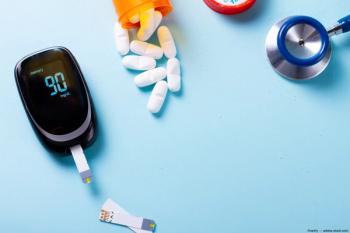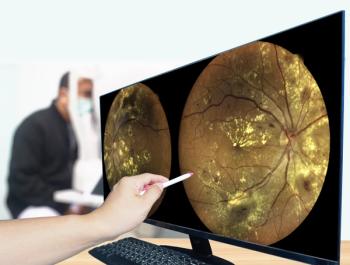
Lessons learned from DRCR.net protocols
This year’s Retina Subspecialty Day at the American Academy of Ophthalmology meeting included a session devoted to diabetes-most of which highlighted study data from the Diabetic Retinopathy Clinical Research Network (DRCR.net).
Here are some of the highlights:
John A. Wells III, MD, in practice at the Palmetto Retina Center, West Columbia, SC, kicked off the session with a “lessons learned” from the DRCR.net’s Protocols I, S, T, and U. Among the lessons:
- Treatment should be initiated with anti-vascular endothelial growth factor (VEGF) therapy, and focal/grid laser should be deferred for 6 months.
- Aflibercept, bevacizumab, and ranibizumab can be given in eyes with baseline acuity of 20/32 to 20/40, recognizing that bevacizumab reduces edema less effectively and is more likely to result in persistent DME.
- The number of injections necessary declines over time.
- In eyes with proliferative DR and co-existing DME, ranibizumab treatment alone should be considered over combined panretinal photocoagulation (PRP) and ranibizumab.
- Continuing anti-VEGF monotherapy can result in continued improvement, even in eyes with persistent DME after at least 6 months of therapy. Adding triamcinolone does not result in better vision outcomes in the short term, and increases the risk for glaucoma.
Visual acuity response at 12 weeks following 3 monthly injections was associated with the 2-year outcomes, regardless of which anti-VEGF therapy is used, said Neil M. Bressler, MD, James P. Gills Professor of Ophthalmology, Wilmer Eye Institute, Johns Hopkins University School of Medicine, Baltimore.
“However, a suboptimal response at 12 weeks did not preclude further meaningful vision improvement of at least 2 lines without switching therapy,” said Dr. Bressler, adding the majority of the variability in 2-year outcomes cannot yet be explained.
There is “little evidence” to suggest that switching from the DRCR.net’s anti-VEGF treatment regimen for DME will result in better vision results.
For example, Dr. Bressler noted Protocol U found mean visual acuity improvement by 6 months was no better in a dexamethasone and ranibizumab group than in a sham and ranibizumab group, even though the dexamethasone and ranibizumab group showed a greater reduction in retinal thickness.
Ranibizumab therapy for DME “may be associated with a simultaneous favorable change in diabetic retinopathy severity (DRS) throughout a 5-year period, despite sequential reduction in anti-VEGF therapy,” said Susan B. Bressler, MD, professor of ophthalmology, Wilmer Eye Institute, Johns Hopkins University School of Medicine, Baltimore.
But, she added, the study design of Protocol I “does not provide a means to identify the optimal number of anti-VEGF injections to achieve or sustain the DR improvement or to evaluate the effect that alterations in DRS may have on vision outcomes.”
Evaluating DR regression with ranibizumab (n = 868) or sham (n = 439) treatment in four pivotal clinical trials-DRCR.net’s Protocol T and Protocol I, and the RISE/RIDE studies-Quan Dong Nguyen, MD, professor of ophthalmology, Byers Eye Institute, Stanford University, Palo Alto, CA, found ranibizumab significantly improved DR in patients with moderate to severe nonproliferative DR (NPDR).
Physicians should consider treating earlier stages of DR to prevent the development of vision-threatening proliferative DR.
“When patients were stratified by baseline DR severity, the highest rates of D improvement were observed in the moderately severe/severe NPDR group, with 63% and 73% of these patients showing significant ≥ 2-step improvement at year 1 and year 2, respectively,” he said.
The 5-year outcomes of Protocol S (which compared ranibizumab and deferred PRP with eyes receiving prompt PRP) found of the 305 participants, although loss to follow-up was relatively high, visual acuity in most study eyes that completed follow-up was very good at 5 years, which was consistent with 2-year results, said Jeffrey G. Gross, MD, founder of the Carolina Retina Center, Columbia, SC.
Severe vision loss or serious proliferative DR complications were uncommon in either group. The ranibizumab group had lower rates of developing vision-impairing DME, he said.
Vision-impairing DME developed in 27 and 53 eyes in the ranibizumab and PRP groups, respectively (cumulative probabilities: 22% versus 38%; hazard ratio, 0.4; 95% CI, 0.3-0.7). No statistically significant differences between groups in major systemic adverse event rates were identified.
For the ranibizumab and PRP groups, the mean (SD) number of injections over 5 years was 19.2 (10.9) and 5.4 (7.9), respectively; the mean visual acuity was 20/25 (approximate Snellen equivalent) in both groups at 5 years.
“Patient-specific factors, including anticipated visit compliance, cost, and frequency of visits, should be considered when choosing a treatment,” he said.
DME can recur after treatments that lead to initial resolution, making follow-up a key component of overall treatment, said David Browning, MD, PhD, Charlotte Eye Ear Nose & Throat Associates, Charlotte, NC, who presented on patient care follow-up after a patient has left a clinical study.
In his center, retention for the primary outcome visit was 96%.
“However, when patients left the studies, follow-up fell off,” he said. “At years 1, 2, and 3 post-study exit, the follow-up percentages were 56%, 44%, and 33%, respectively.”
Patients that had been enrolled in Protocols I and T largely retained their vision gains, but those in Protocol B (which compared intravitreal triamcinolone injections to focal laser) did not.
He suggested that aspects of follow-up that are present during a clinical study, such as gas cards, call-backs by study coordinators, and ongoing coaching and education, become reimbursable under Medicare and Medicaid, believing they may be more cost-effective than the current system of care.
Finally, Mark W. Johnson, MD, professor of ophthalmology, Kellogg Eye Center, University of Michigan, Ann Arbor, MI, said that while anti-VEGF therapy for proliferative DR necessitates ongoing treatment, “in the real world, diabetic patients are prone to significant losses to follow-up.”
These losses may be “owing to unanticipated health issues (33%), financial hardship (17%), noncompliance (33%), and other reasons,” said Dr. Johnson about his analysis of 12 eyes of 11 patients who had been lost to follow-up for ≥ 4 months.
The final visual outcomes?
“Six of the 12 eyes had a final VA of hand motion or worse,” he said, and 11 eyes (92%) had lost at least 3 lines of vision.
Newsletter
Keep your retina practice on the forefront—subscribe for expert analysis and emerging trends in retinal disease management.










































